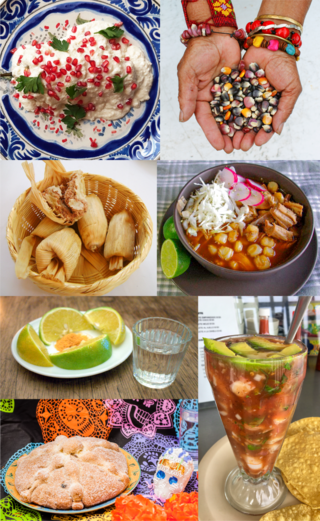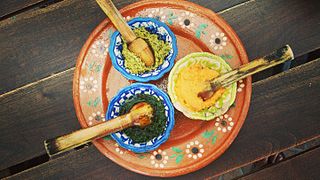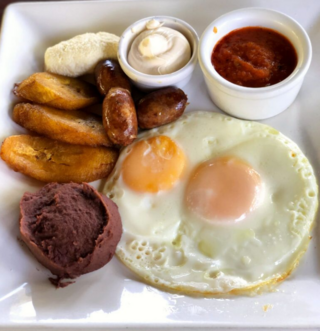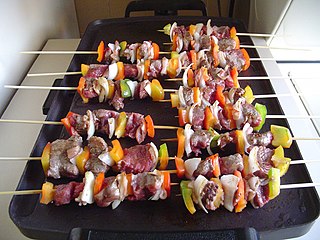
Mexican cuisine consists of the cooking cuisines and traditions of the modern country of Mexico. Its earliest roots lie in Mesoamerican cuisine. Mexican cuisine ingredients and methods begin with the first agricultural communities such as the Olmec and Maya who domesticated maize, created the standard process of nixtamalization, and established their foodways. Successive waves of other Mesoamerican groups brought with them their cooking methods. These included: the Teotihuacanos, Toltec, Huastec, Zapotec, Mixtec, Otomi, Purépecha, Totonac, Mazatec, Mazahua, and Nahua. With the Mexica formation of the multi-ethnic Triple Alliance, culinary foodways became infused.

An enchilada is a Mexican dish consisting of a corn tortilla rolled around a filling and covered with a savory sauce. Enchiladas can be filled with various ingredients, including meats, cheese, beans, potatoes, vegetables, or combinations. Enchilada sauces include chili-based sauces, such as salsa roja, various moles, tomatillo-based sauces, such as salsa verde, or cheese-based sauces, such as chile con queso.

Tostada is the name given to various dishes in Mexico and Guatemala which include a toasted tortilla as the main base of their preparation.

Chilaquiles are a traditional Mexican breakfast dish made with tortillas.

Salsa encompasses a variety of sauces used as condiments for tacos and other Mexican and Mexican-American foods, and as dips for tortilla chips. They may be raw or cooked, and are generally served at room temperature.

Nicaraguan cuisine includes a mixture of Mesoamerican, Chibcha, Spanish, Caribbean, and African cuisine. Despite the blending and incorporation of pre-Columbian, Spanish and African influences, traditional cuisine differs from the western half of Nicaragua to the eastern half. Western Nicaraguan cuisine revolves around the Mesoamerican diet of the Chorotega and Nicarao people such as maize, tomatoes, avocados, turkey, squash, beans, chili, and chocolate, in addition to potatoes which were cultivated by the Chibcha people originating from South America and introduced meats like pork and chicken. Eastern Nicaraguan cuisine consists mostly of seafood and coconut.

Salvadoran cuisine is a style of cooking derived from the nation of El Salvador. The indigenous foods consist of a mix of Amerindian cuisine from groups such as the Lenca, Pipil, Maya Poqomam, Maya Chʼortiʼ, Alaguilac and Cacaopera peoples and some African influences. Many of the dishes are made with maize (corn). There is also heavy use of pork and seafood. European ingredients were incorporated after the Spanish conquest.

New Mexican cuisine is the cuisine of the Southwestern US state of New Mexico. The region is primarily known for its fusion of Pueblo Native American cuisine with Hispano Spanish and Mexican cuisine originating in Nuevo México. This Southwestern culinary style is popular beyond the current boundaries of New Mexico, and is found throughout the old territories of Nuevo México and the New Mexico Territory, today the state of Arizona, parts of Texas, and the southern portions of Colorado, Utah, and Nevada.

A taquito, taco dorado, rolled taco, or flauta is a Mexican dish that typically consists of a small rolled-up tortilla that contains filling, including beef, cheese or chicken. The filled tortilla is then shallow-fried or deep-fried. The dish is often topped with condiments such as sour cream and guacamole. Corn tortillas are generally used to make taquitos. The dish is more commonly known as flautas when they are larger than their taquito counterparts, and can be made with either flour or corn tortillas.

Chile con queso, sometimes simply called queso, is an appetizer or side dish of melted cheese and chili peppers, typically served in Tex-Mex restaurants as a dip for tortilla chips.

Carnitas, literally meaning "little meats", in Mexican cuisine, is a dish made by braising, simmering and frying pork in its own fat, lard or cooking oil. The name “Carnitas” is, historically, the vulgar, colloquial name given in Mexico for the French dish Rillons de Tours also known in Spanish as Chicharrón de Tours.

Honduran cuisine is a fusion of Mesoamerican, Spanish, Caribbean and African cuisines. There are also dishes from the Garifuna people. Coconut and coconut milk are featured in both sweet and savory dishes. Regional specialties include sopa de caracol, fried fish, tamales, carne asada and baleadas. Other popular dishes include meat roasted with chismol and carne asada, chicken with rice and corn, and fried fish with pickled onions and jalapeños. In the coastal areas and the Bay Islands, seafood and some meats are prepared in many ways, including with coconut milk. Among the soups the Hondurans enjoy are bean soup, mondongo soup, seafood soups and beef soups. Generally all of these soups are mixed with plantains, yuca, and cabbage, and served with corn tortillas.
Mexico: One Plate at a Time is a television series starring chef Rick Bayless and, on occasional episodes, his daughter Lanie Bayless. The show is distributed to public television stations by WTTW and American Public Television and also airs on PBS's Create channel, with reruns on ABC's Live Well Network digital subchannel. Filming of new shows concluded in September 2018 with the twelfth season.

Most traditional foods in Guatemalan cuisine are based on Maya cuisine, with Spanish influence, and prominently feature corn, chilies and beans as key ingredients. Guatemala is famously home to the Hass avocado.

A sope is a traditional Mexican dish consisting of a fried masa base with savory toppings. Also known as picadita, it originates in the central and southern parts of Mexico, where it was sometimes first known as pellizcadas. It is an antojito, which at first sight looks like an unusually thick tortilla with vegetables and meat toppings.

Mexican street food, called antojitos, is prepared by street vendors and at small traditional markets in Mexico. Street foods include tacos, tamales, gorditas, quesadillas, empalmes, tostadas, chalupa, elote, tlayudas, cemita, pambazo, empanada, nachos, chilaquiles, fajitas, tortas, even hamburgers and hot dogs, as well as fresh fruits, vegetables, beverages and soups such as menudo, pozole and pancita. Most are available in the morning and the evening, as mid-afternoon is the time for the main formal meal of the day. Mexico has one of the most extensive street food cultures in Latin America, and Forbes named Mexico City as one of the foremost cities in the world in which to eat on the street.

Oaxacan cuisine is a regional cuisine of Mexico, centered on the city of Oaxaca, the capital of the eponymous state located in southern Mexico. Oaxaca is one of the country's major gastronomic, historical, and gastro-historical centers whose cuisine is known internationally. Like the rest of Mexican cuisine, Oaxacan food is based on staples such as corn, beans, and chile peppers, but there is a great variety of other ingredients and food preparations due to the influence of the state's varied geography and indigenous cultures. Corn and many beans were first cultivated in Oaxaca. Well-known features of the cuisine include ingredients such as chocolate, Oaxaca cheese, mezcal, and grasshoppers (chapulines), with dishes such as tlayudas, Oaxacan-style tamales, and seven notable varieties of mole sauce. The cuisine has been praised and promoted by food experts such as Diana Kennedy and Rick Bayless and is part of the state's appeal for tourists.

The cuisine of Mexico City encompasses a variety of cuisines. Restaurants specialize in the regional cuisines of Mexico's 31 states, and the city also has several branches of internationally recognized restaurants.


























































